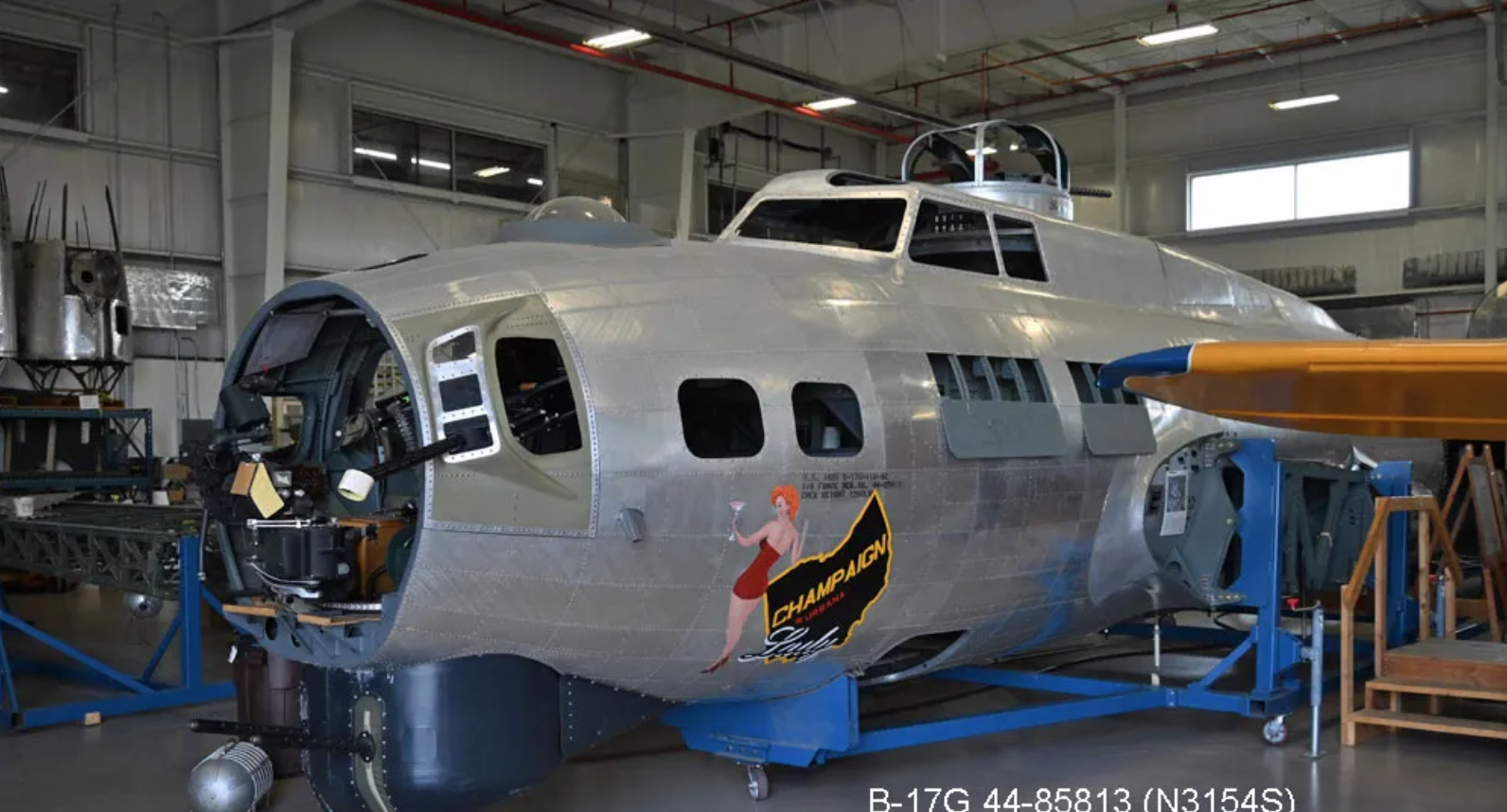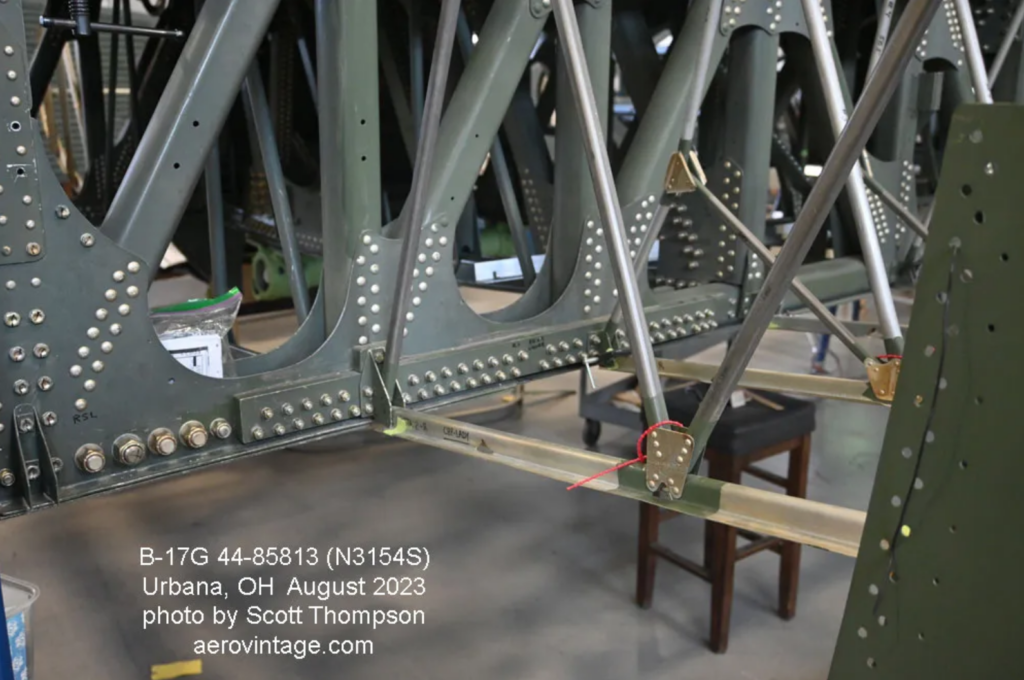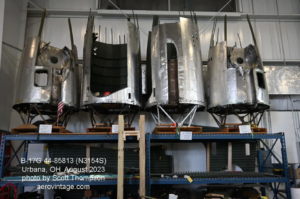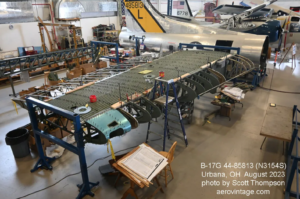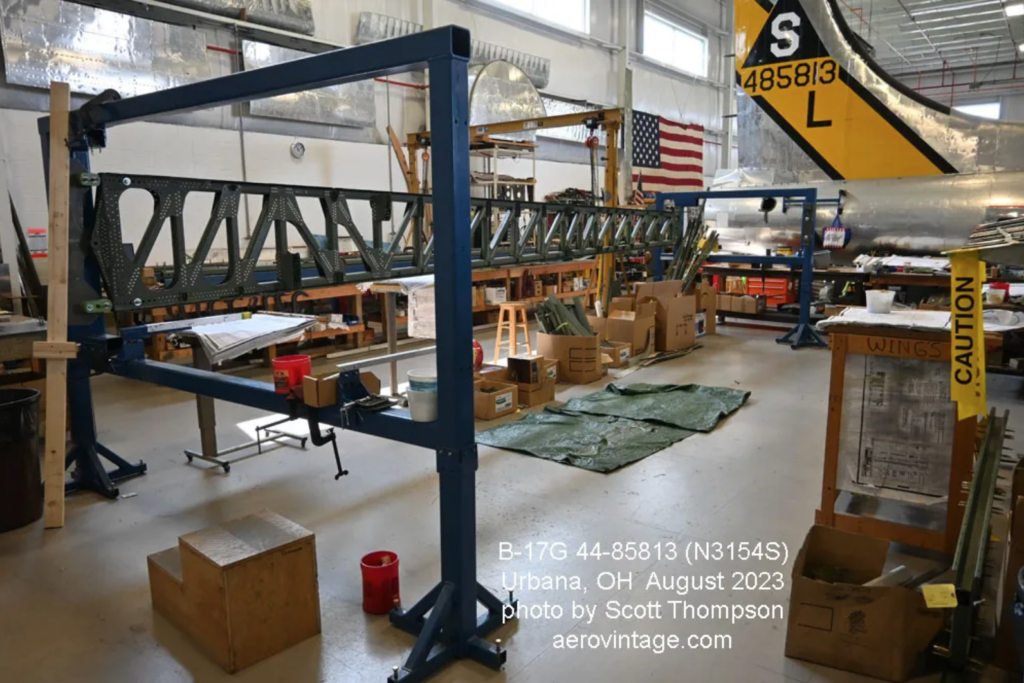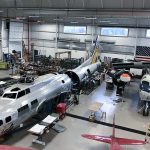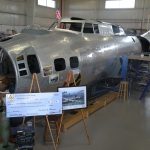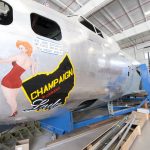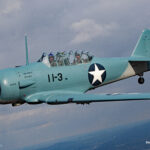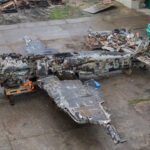By Scott Thompson of Aero Vintage
The restoration of B-17G 44-85813, otherwise known as Champaign Lady, continues to make solid progress at Urbana, Ohio. The decades-long effort by the Champaign Air Museum is now concentrated on the rebuilding, really re-creation, of the wing sections, both inboard and outboard. The fuselage itself is nearly structurally complete. The restoration project began in 2005 by Jerry Shiffer, who shortly afterward was killed in an airplane accident. However, his three adult children (Dave, Eric, and Andrea) took up the project and have driven it forward over the past eighteen years. The large volunteer team under the direction of project manager Randy Kemp will complete the rebuild of the B-17G to airworthy condition.
As a recap, the project began as the compilation of the remaining sections of several B-17s. The fuselage was rebuilt from parts of B-17Gs 44-83722 and 44-83316. The inner wing panels came from 44-85813, and the outer wing panels from 44-83722. The vertical stabilizer came from 44-83525. The nose compartment and the radio room compartment had to be built as a new structure. The other subassemblies and components have been gathered from many different sources from around the world. Because a large part of the airframe came from 44-85813 and that airframe had the documented civil history of N6694C, this airplane is moving forward as the restoration of 44-85813 under the new civil registration of N3154S. The long history of this B-17 which, by the way, was one of the three post-war five-engine test beds, is told in words and photos in Final Cut: the Post-War B-17 Flying Fortress and Survivors.
Since the inner wing panels are a high-interest B-17 topic these days, it is interesting to take a closer look at what the Champaign Lady team is doing. As it happened, 44-85813 (operating as N6694C) was severely damaged in an April 1980 accident at Bear Pen, South Carolina, while operating as an air tanker. The fuselage was largely burnt out. The wings, though damaged, were relatively intact.
Beginning in 2012, the right inner wing panel was disassembled by the restoration team. Disassembly meant very carefully drilling out thousands of rivets that held the skin, spar structure, supporting ribs, and other components together. The engine nacelles were similarly removed and disassembled. As components were inspected, an exacting rebuild was begun in a fixed structure to ensure alignment and exact fit. The original spar tubes are being used after being thoroughly inspected. Some repairs were needed whereby new material was spliced into the existing spar tubes as per the original USAF (Boeing-written) technical order for wing repairs.
Most of the supporting spar trusses have been re-manufactured from the Boeing specifications, as were the ribs. So, after eleven years of work, where does the right wing inner panel stand? Most of the underlying structure is completed and the corrugated sub-skin is being manufactured where needed, otherwise, the original sub-skin is being used. The leading edges are being attached, as is the trailing edge assembly. The nacelles are rebuilt and ready to go back into the wing. The right main landing gear support is mounted in the wing structure. The wing still has a long way to go, at least by outward appearance, though most components are rebuilt and ready to be reassembled.
Meanwhile, work is just getting started on the left inner wing panel. The panel has been completely disassembled and spar tube repairs are underway. It appears only one section will need to be spliced with new material. The spar tubes will then be reassembled into the spar structure and the wing re-construction will begin in the dedicated wing fixture. Many of the needed components have already been built or rebuilt, and it is hoped that the learning curve achieved with the right wing will allow the work on the left wing to go much faster.
It should be noted how exact the work on the wings is. Most of the spar components are riveted to the spar tubes, a complicated process. How does one buck rivets inside a small, twenty-five-foot long tube? It’s not easy but the Champaign Lady team has figured out how to do it. Any tiny mistake, however, can greatly multiply the work required, so great care is taken to get it right the first time.
Both outer wing panels, as noted earlier, have come from atomic test target aircraft 44-83722. This airplane was dragged off the Nevada Test Site in 1965 and subsequently used for parts to support air tankers. The outer wing panels were intact but did suffer from damage during the several nuclear tests they endured.
Overall, the project is immense and impressive. Unless one digs into the intricacies of what is involved with restoring—or building—an airplane the size of a B-17, the true scope of the task cannot begin to be appreciated. Hats off to the team of volunteers rebuilding this airplane. It will fly one day…when that might be is still many years off in the future. In the meantime, it is a fascinating project to watch and support. Speaking of donations…yes, everybody can pitch in to keep this project moving. The Champaign Air Museum has a dedicated webpage with more information.
Many thanks indeed to Scott A. Thompson for allowing us to reproduce this article describing Champaign Lady’s present condition… his book, Final Cut: The Post-War B-17 Flying Fortress and Survivors as well as other titles are the gold standard when it comes to the airframe history it describes!







